There are 12 species of turtles in New Mexico, but you can find 123 species of reptiles and amphibians in total in the Southwestern state. Most of them are natives, but there are a few foreign invaders that are making this state their home.
Red Eared Sliders and the Common Snapping turtle are now found in New Mexico, and were probably escapees, or were released by previous owners.
In this list, we go over all the turtles found living in the Land of Enchantment. You can use this guide simply to have the knowledge, to try and photograph them all, or to help you decide which of these turtles would be a good pet for you.
Whatever the case, let’s find out what turtles live in New Mexico.
Table of Contents
Pond Slider Turtles in New Mexico
1. Big Bend Slider

- Experience Level: Beginner
- Family: Emydidae
- Scientific Name: Trachemys Gaigeae
- Other Names: Mexican Plateau Slider
- Adult Size: Between 5 and 11 inches
- Lifespan: Between 20 and 30 years
- Average Price Range: Very rare, up to $1,000
- Conservation Status: Vulnerable
Big Bend Sliders are very similar to Red Eared Sliders, and in fact, these species often interbreed. This is causing problems with the Big Bend Sliders because their numbers are dwindling already, and when they mate with a different subspecies, their numbers dwindle even more.
These turtles like to inhabit large rivers such as the Rio Grande, and the Rio Concho and are found in New Mexico, Texas, and Northern Mexico. They spend their time either in the water, or basking on fallen logs, and river banks.
When approached, they will disappear into the water and quickly swim to the bottom. Females will leave the water to search for nesting sites and lay eggs, but these turtles rarely leave the water for anything else.
These turtles look similar to their cousin the Red Eared Slider. They have olive colored shells with a lot of orange, green, brown, and yellowish markings. Their skin is highly striped, though the Big Bend Sliders tend to be slightly lighter in their younger years.
The main distinction between the two is the color markings behind the eyes. On the Big Bend Slider, the “ear” markings are pale yellow to orange, and they are usually more rounded, whereas the Red Eared Slider has prominent, bright red patches that are more ovate.
Big Bend Sliders start out as carnivores, but will slowly transition to being herbivores the older they get. Juveniles will eat insects, worms, small fish, and other small aquatic organisms, but adults feed on aquatic plants.
2. Red Eared Slider
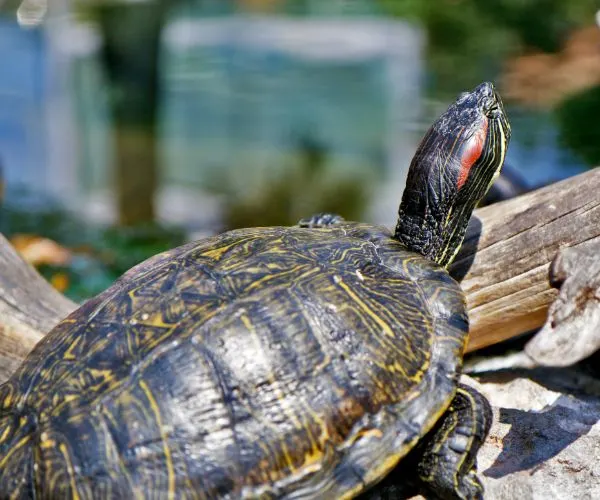
- Experience level: Beginner
- Family: Emydidae
- Scientific Name: Trachemys scripta elegans
- Common Name: Pond slider, Red-eared terrapin, Water slider
- Average Adult Size: 6 – 8 inches
- Life Span: 20 to 40 years
- Average Price Range: approximately $30 to $100
- Conservation Status: Least concern
Red Eared Sliders are very popular pets. They are cute, brightly colored, and relatively inexpensive when they are very small. Unfortunately, many people don’t fully realize the care involved in keeping a turtle. Especially one that can get somewhat large like the Red Eared Slider.
This often leads to regret, especially for parents who get these pets for their children, only to have the child get bored with the turtle. This leads to many frustrated parents letting the turtles loose in the wild because they don’t know what to do.
Unfortunately, Red Eared Sliders quickly become invasive in non-native habitats, as they are in New Mexico.
Red Eared Sliders have green, or olive green upper shells (carapace) with yellow, green, orange, brown, and black stripes and swirls. The lower part of the shell (plastron) is pale yellow with varying amounts of black spots.
Their skin is dark green to nearly black with yellow stripes, and the eponymous red patches behind the eyes that look like ears.
While these turtles can make a home in nearly any type of water, they prefer slow-moving waterways such as lakes, and large, meandering rivers. They love to bask, and you’ll often find them crowding logs, rocks, and other floating debris.
Red Eared Sliders are voracious omnivores that will feed on nearly anything they can get into their mouths. Items include fish, tadpoles, frogs, snails, crayfish, insects, carrion, seeds, algae, stems, leaves, and roots of vegetation.
Tortoises in New Mexico
3. Agassiz’s Desert Tortoise

- Experience level: Beginner
- Family: Testudinidae
- Scientific Name: Gopherus agassizii
- Common Name: Mojave Desert Tortoise
- Average Adult Size: 9-15 inches
- Life Span: 50 – 80 years
- Average Price Range: Illegal to purchase a desert tortoise–Must be adopted
- Conservation Status: Vulnerable
Agassiz’s Desert tortoise is a medium sized, slow moving tortoise that spends a lot of its time hiding from the heat in burrows they dig themselves.
These tortoises have high domed, ridged, dusty carapaces. They are drab colored, usually brown or sandy colored all over, and have wide, spurred front feet, and elephant-like back legs.
This tortoise is federally protected because they are a keystone species. This means they provide benefits for the environment and other organisms where it lives. These turtles dig dozens of deep, long burrows throughout their lifetime, and help disperse native plant seeds.
Over 300 species of animals rely on Desert tortoise burrows to either escape the stifling heat, cold nights and winters, or for protection from predators.
The Agassiz’s Desert tortoise is an herbivore that eats most types of native plants in its habitat. When they feed on fruits and seed pods, the seeds will pass unharmed through the digestive tract. When the tortoise roams and defecates, it spreads seeds that may sprout and grow, many plants rely on this type of dispersal by the Desert tortoise.
It’s illegal to harm or take these tortoises from their homes, so if you are looking to keep one as a pet, you will have to get a special permit and find a tortoise rescue agency so you can adopt one.
Box Turtles in New Mexico
4. Ornate Box Turtle
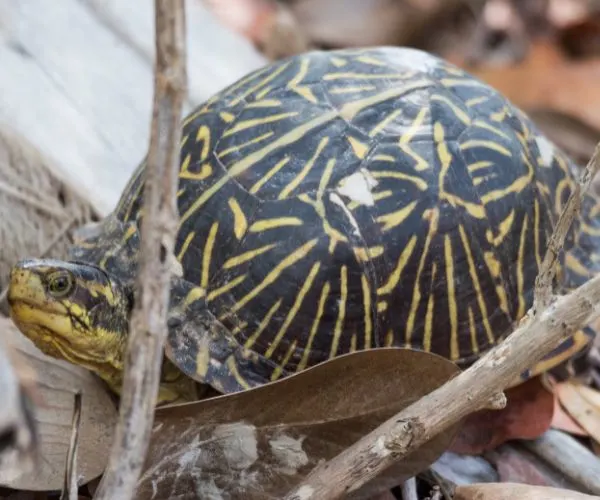
- Experience Level: Intermediate to Expert
- Family: Emydidae
- Scientific Name: Terrapine ornata
- Other Names: Box Tortoise, Western Box Turtle
- Adult Size: 4 to 5 inches (10 to 12.5 cm)
- Life Span: 30 to 40 years
- Average Price Range: $150 to $450
- Conservation Status: Near threatened
Ornate box turtles are small, land dwelling turtles that can be found in several areas of New Mexico. These turtles need water to drink, and will sometimes soak in small pools, but they rarely enter large bodies of water.
To cool off during the hot summer months, or protect themselves from the chill of winter, these turtles burrow into the ground.
You’ll recognize Ornate Box turtles by their high domed, dark colored carapace with bright yellow or orange stripes and spots. They also have a yellow or orange stripe running down the middle of their shell.
Their skin and scales are dark brown with yellowish, or orange spots and patches. They have a hinged plastron that is able to close them inside their shell to protect them from predators and other hazards.
Ornate Box turtles are opportunistic omnivores. They will feed on whatever they come across in their wanderings. They will eat insects, carrion, fungi, berries and fruits, worms, small lizards and snakes, plants, and flowers.
5. Desert Box Turtle

- Experience level: Intermediate to Expert
- Family: Emydidae
- Scientific Name: Terrapene ornata luteola
- Common Name: Sonoran Box Turtle, Box turtle, Western box turtle
- Average Adult Size: 4 – 6 inches
- Life Span: 40 – 60 years
- Average Price Range: Approximately $50 – $250
- Conservation Status: Near Threatened
Desert Box turtles look similar to Ornate Box turtles, though the former has more muted colors. The Desert Box turtle has a dark carapace with light colored lines and spots, and a hinged plastron.
The Desert Box turtle can grow slightly larger than the Ornate turtle. Though they are similar, the Desert Box turtle is slightly more adapted to life in the desert. They are often found in grasslands and prairies where the soil is soft and loose, especially around prairie dog communities.
These turtles also dig small, shallow burrows to hide from extreme heat and hide during the winter.
Though omnivorous, the Desert Box turtle tends to prefer insects over plant matter. They have even been observed digging through cow dung to eat the beetles and other bugs found within.
Softshell Turtles in New Mexico
6. Midland Smooth Softshell Turtle

- Experience level: Intermediate
- Family: Trionychidae
- Scientific Name: Apalone Mutica
- Other Names: N/A
- Average Adult Size: 5 – 14 inches
- Life Span: 10 – 20 years
- Average Price Range: $50 – $150
- Conservation Status: Least Concern
Midland Softshell turtles are found in a few northeastern areas of New Mexico. They like to live in large rivers with swift currents, and sandy bottoms.
You’ll recognize these thin turtles by their flexible shell and the flattened clay look. Midland Softshell turtles are sandy tan, to dark brown on both the carapace and their skin. Sometimes the spine and ribs are visible on the upper shell. The underside is much lighter, nearly white.
They may have some darker spots or patterns on the upper, leathery shell, though these fade with age. You can also tell these turtles by the black bordered, white stripe that extends back from the eye.
These turtles are very good swimmers, and actually very swift on land. Because of the limited protection of their flexible shell, they are aggressive on land. They can bite and use their sharp claws to defend themselves, so it’s not advised to try and handle these turtles.
Midland Smooth Softshell turtles are mostly carnivorous. Sometimes they bury themselves in the sandy substrate and wait for food to come near, then they strike and eat it. They will feed on insects, tadpoles, salamanders, frogs, fish, crustaceans, and snails.
7. Texas Spiny Softshell
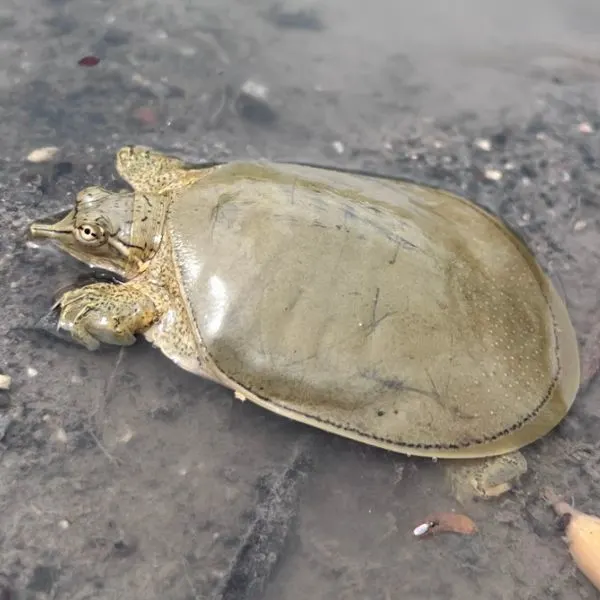
- Experience level: Intermediate to Expert
- Family: Trionychidae
- Scientific Name: Apalone spinifera emoryi
- Common Name: Spiny Softshell Turtle
- Average Adult Size: 5 – 17 inches
- Life Span: 40 – 60 years
- Average Price Range: Approximately $50 – 280
- Conservation Status: Least Concern
The Texas Spiny Softshell turtle is slightly larger than the Midland, and they have a bumpy ridge along the front of the flexible carapace. If you were to touch the carapace, it may feel coarse and sandy because of the tiny bumps covering it.
They have a very long necks that can reach over and below themselves, so extreme care should be exercised when handling these turtles. They have a sharp beak that can leave a nasty bite if it gets a hold of you.
They have the same coloration as the Midland Smooth Softshell turtle.
Swift flowing rivers with sandy or muddy bottoms are their favorite habitats. If they can’t stretch their neck and nose up to breathe air, they can still stay submerged for over an hour. Softshell turtles can absorb oxygen from the water through their skin.
Females are much larger than males, they can grow to double the size.
Texas Spiny Softshell turtles are carnivorous. They will eat fish, amphibians, tadpoles, insects, crayfish, and mollusks. They have been found with small amounts of vegetation in their stomachs, but that may be from them eating snails on plants, and getting the vegetation secondarily.
Mud Turtles in New Mexico
8. Sonora Mud Turtle

- Experience level: Beginner – Intermediate
- Family: Kinosternidae
- Scientific Name: Kinosternon sonoriense
- Other Names: Sonoyta Mud Turtle, Mud Turtle
- Average Adult Size: 5 to 7 inches
- Life Span: 40 years
- Average Price Range: Approximately $200 and up
- Conservation Status: Endangered
The Sonora Mud turtle only appears in Arizona, New Mexico, and Mexico. They are quite endangered, and because of extended droughts, their numbers are dropping quickly. There are efforts to revive this species, but it takes a lot of time to make a difference.
These small turtles have an oval, olive, to dark brown carapace and a hinged plastron. Turtles of the Kinosternidae family have pungent smelling musk glands. When threatened or harmed, they will release this disgusting musk in order to get away from their captors.
They have webbed feet, and olive-grey skin with dark spots all over.
Sonora Mud turtles inhabit streams, ponds, rivers, and wetlands with plenty of vegetation and soft banks. They bury their eggs in soft mud and will bury themselves to hibernate. Extreme drought is fatal to these turtles as they need a wet or humid environment to survive.
The Sonora Mud turtle will mostly eat insects, and other aquatic organisms, but when they aren’t available, the turtle will feed on vegetation.
9. Yellow Mud Turtle

- Experience level: Intermediate
- Family: Kinosternidae
- Scientific Name: Kinosternon flavescens
- Common Name: Mud Turtle, Yellow Mud Turtle
- Average Adult Size: 5 – 7 inches
- Life Span: 40 years
- Average Price Range: Approximately $80 to $300
- Conservation Status: Conservation Status: Federally listed as least concern, but threatened or endangered in most states.
Yellow Mud turtles have high domed, flat topped, yellow to brown carapaces. The scutes (growth plates on the upper and lower shell) usually have a black border. The chin and the throat are usually yellow, while the upper skin is darker and greenish.
Nearly any watery habitat is suitable for the Yellow Mud turtle, though they prefer waters with soft substrates and abundant vegetation. They spend time in the water and on land, though they typically come on land in the evening and early morning hours.
Aquatic organisms such as snails are a favorite food of these turtles. They also consume insects, fish, crustaceans, and the occasional plant. While on land they feed on nightcrawlers.
Cooters in New Mexico
10. Rio Grande Cooter

- Experience Level: Beginner to Intermediate
- Family: Emydidae
- Scientific Name: Pseudemys Gorzugi
- Other Names: Rio Grande River Cooter, Western River Cooter
- Adult Size: Between 8 and 14 inches
- Lifespan: Between 20 and 40 years, and up to 60 in the wild
- Average Price Range: Between $20 and $150
- Conservation Status: Near threatened
Rio Grande Cooters are large aquatic turtles found in Texas, Mexico, and New Mexico. They have green shells with bright coloration. Young turtles have varying colors and sometimes concentric patterns of red, orange, green, brown, or yellow on the carapace.
As they age, these colors fade and are usually covered in mud or algae. Their plastron is pale yellow. The skin is olive, dark brown, or nearly black with yellow, or pale yellow stripes.
They look very similar to painted turtles, but these shelled reptiles get larger and have thicker yellow and green stripes on their head, neck, and limbs. Many times, there are stripes above and below the mouth that combine to make a sideways Y.
You’ll find these turtles in the Rio Grande river, oxbow lakes, large ponds, and other slow moving bodies of water.
Here they eat algae, plants, fish, amphibians, insects, crustaceans, and worms.
Painted Turtles in New Mexico
11. Western Painted Turtle
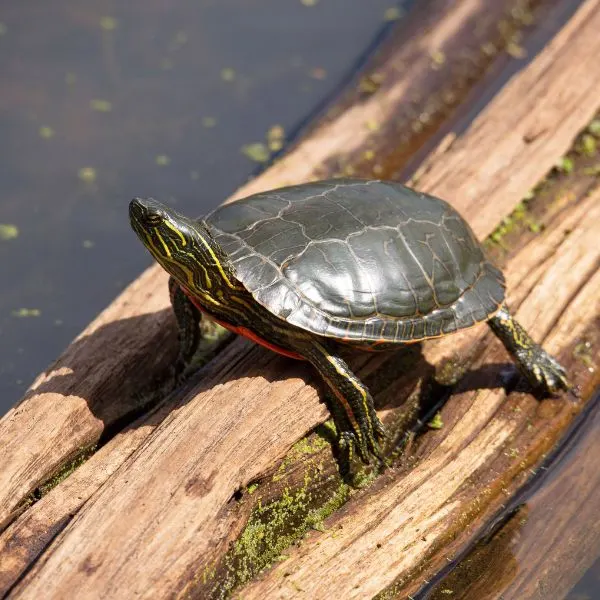
- Experience Level: Beginner
- Family: Emydidae
- Scientific Name: Chrysemys Picta Belli
- Other Names: N/A
- Adult Size: Between 4 and 10 inches
- Life Span: Between 30 and 50 years
- Average Price Range: Between $30 and $150
- Conservation Status: Least concern
Western painted turtles have smooth, dark colored carapaces. When they are born, the shells are olive colored, but they darken as they age. These turtles love to bask in the sun, and all that time outside deepens the color of their shells and skin.
The marginal scutes have faded stripes and swirls, while the underside is bright red. This deep, rich, color continues to the plastron. It’s dark orange to red, with dark brown to black patterns that mirror along the midline.
They have olive skin with yellow stripes all over. There is usually a small circle or oval of yellow behind the eyes of Western Painted turtles.
These turtles like waters with slow currents and will generally avoid streams and rivers with swift flowing rapids. They also look for places with a lot of vegetation and muddy bottoms so they can hibernate through the winter.
This species is omnivorous, but juveniles consume more protein sources, while adults like their veggies more.
Snapping Turtles in New Mexico
12. Common Snapping Turtle
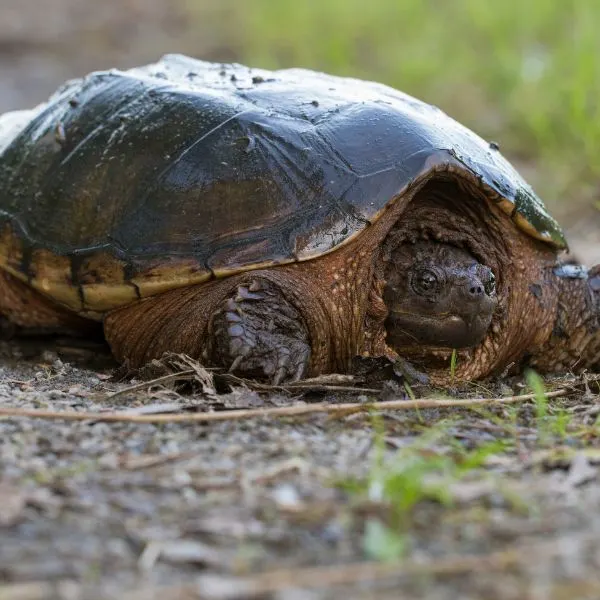
- Experience level: Intermediate to Expert
- Family: Chelydrida
- Scientific Name: Chelydra Serpentina
- Other Names: Snapping Turtle, Snapper, Eastern Snapping Turtle
- Average Adult Size: 8 to 20 inches
- Life Span: 30 – 50 years
- Average Price Range: Approximately $40 to $120
- Conservation Status: Least concern
Common Snapping turtles are not native to New Mexico. Their natural habitat ranges up to the Rocky Mountains, but pockets have been introduced in several of the Western states.
Snapping turtles prefer stagnant and still waters such as swamps, ponds, wetlands, and bogs, but they can make their home in nearly any type of water.
These are large turtles with relatively small shells that don’t cover much of their limbs and flesh. Their plastron is especially small, but it allows for a wider range of movement.
Snapping turtles have wide heads, long limbs, and a long jagged looking tail. Their skin can be a muddy yellow or dark brown, and their shell is dark brown and often covered in mud and algae.
In the water, Snapping turtles are docile, and their first instinct is to get away from people or danger. On land though, these big turtles turn very aggressive. They will hiss and bite if you get close, and just so you know, they have very long necks that strike as fast as rattlesnakes!
Most times, Snapping turtles hang out at the bottom of their habitat—they rarely bask in the sun—and wait for food to swim near. They will eat nearly anything that fits in their mouths. Some food items include small turtles, frogs and toads, fish, crayfish, snails, salamanders, and even waterfowl if they get close enough.
Wrapping up
We just covered all the turtles you can find in New Mexico. From small mud turtles, and flattened softshell turtles, to terrestrial box turtles and the desert tortoise, New Mexico has a wide range.
Use this guide as a herping guide or to help you decide on a pet turtle for your own. Just be sure to check local laws, as some species are illegal, and you may need a permit to own certain turtle types. Check on local breeders and make sure you get captive bred turtles, taking these species from the wild puts a strain on their numbers and weakens the local habitat.
If you’ve enjoyed this list and want to obtain one of these turtles for yourself, don’t hesitate to comment below, we love hearing from our readers!
Other nearby states
- Turtles in Arizona
- Turtles in Colorado
- Turtles in Kansas
- Turtles in Oklahoma
- Turtles in Texas
- Turtles in Utah
Table of Contents
